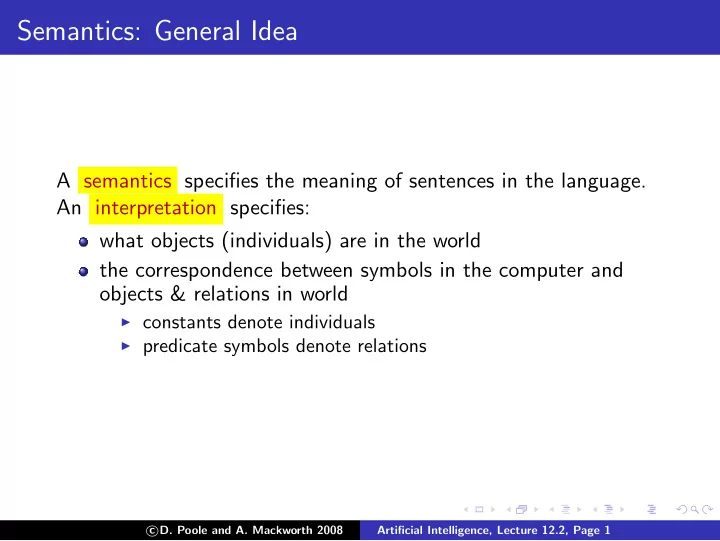

Semantics: General Idea A semantics specifies the meaning of sentences in the language. An interpretation specifies: what objects (individuals) are in the world the correspondence between symbols in the computer and objects & relations in world ◮ constants denote individuals ◮ predicate symbols denote relations � D. Poole and A. Mackworth 2008 c Artificial Intelligence, Lecture 12.2, Page 1
Formal Semantics An interpretation is a triple I = � D , φ, π � , where D , the domain, is a nonempty set. Elements of D are individuals. φ is a mapping that assigns to each constant an element of D . Constant c denotes individual φ ( c ). π is a mapping that assigns to each n -ary predicate symbol a relation: a function from D n into { TRUE , FALSE } . � D. Poole and A. Mackworth 2008 c Artificial Intelligence, Lecture 12.2, Page 2
Example Interpretation Constants: phone , pencil , telephone . Predicate Symbol: noisy (unary), left of (binary). D = { ✂ , ☎ , ✎ } . φ ( phone ) = ☎ , φ ( pencil ) = ✎ , φ ( telephone ) = ☎ . π ( noisy ): � ✂ � � ☎ � � ✎ � FALSE TRUE FALSE π ( left of ): � ✂ , ✂ � � ✂ , ☎ � � ✂ , ✎ � FALSE TRUE TRUE � ☎ , ✂ � � ☎ , ☎ � � ☎ , ✎ � FALSE FALSE TRUE � ✎ , ✂ � � ✎ , ☎ � � ✎ , ✎ � FALSE FALSE FALSE � D. Poole and A. Mackworth 2008 c Artificial Intelligence, Lecture 12.2, Page 3
Important points to note The domain D can contain real objects. (e.g., a person, a room, a course). D can’t necessarily be stored in a computer. π ( p ) specifies whether the relation denoted by the n -ary predicate symbol p is true or false for each n -tuple of individuals. If predicate symbol p has no arguments, then π ( p ) is either TRUE or FALSE . � D. Poole and A. Mackworth 2008 c Artificial Intelligence, Lecture 12.2, Page 4
Truth in an interpretation A constant c denotes in I the individual φ ( c ). Ground (variable-free) atom p ( t 1 , . . . , t n ) is true in interpretation I if π ( p )( t ′ 1 , . . . , t ′ n ) = TRUE , where t i denotes t ′ i in interpretation I and false in interpretation I if π ( p )( t ′ 1 , . . . , t ′ n ) = FALSE . Ground clause h ← b 1 ∧ . . . ∧ b m is false in interpretation I if h is false in I and each b i is true in I , and is true in interpretation I otherwise. � D. Poole and A. Mackworth 2008 c Artificial Intelligence, Lecture 12.2, Page 5
Example Truths In the interpretation given before: noisy ( phone ) true noisy ( telephone ) true noisy ( pencil ) false left of ( phone , pencil ) true left of ( phone , telephone ) false noisy ( pencil ) ← left of ( phone , telephone ) true noisy ( pencil ) ← left of ( phone , pencil ) false noisy ( phone ) ← noisy ( telephone ) ∧ noisy ( pencil ) true � D. Poole and A. Mackworth 2008 c Artificial Intelligence, Lecture 12.2, Page 6
Models and logical consequences (recall) A knowledge base, KB , is true in interpretation I if and only if every clause in KB is true in I . A model of a set of clauses is an interpretation in which all the clauses are true. If KB is a set of clauses and g is a conjunction of atoms, g is a logical consequence of KB , written KB | = g , if g is true in every model of KB . That is, KB | = g if there is no interpretation in which KB is true and g is false. � D. Poole and A. Mackworth 2008 c Artificial Intelligence, Lecture 12.2, Page 7
User’s view of Semantics 1. Choose a task domain: intended interpretation. 2. Associate constants with individuals you want to name. 3. For each relation you want to represent, associate a predicate symbol in the language. 4. Tell the system clauses that are true in the intended interpretation: axiomatizing the domain. 5. Ask questions about the intended interpretation. 6. If KB | = g , then g must be true in the intended interpretation. � D. Poole and A. Mackworth 2008 c Artificial Intelligence, Lecture 12.2, Page 8
Computer’s view of semantics The computer doesn’t have access to the intended interpretation. All it knows is the knowledge base. The computer can determine if a formula is a logical consequence of KB. If KB | = g then g must be true in the intended interpretation. If KB �| = g then there is a model of KB in which g is false. This could be the intended interpretation. � D. Poole and A. Mackworth 2008 c Artificial Intelligence, Lecture 12.2, Page 9
Role of Semantics in an RRS kim in ( kim,r123 ) . r123 part_of ( r123,cs_building ) . r023 in ( X,Y ) ← cs_building part_of ( Z,Y ) ∧ in ( , ) in ( X,Z ) . part_of ( , ) person ( ) in ( kim,cs_building ) � D. Poole and A. Mackworth 2008 c Artificial Intelligence, Lecture 12.2, Page 10
Recommend
More recommend